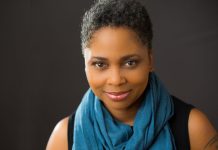This interview first appeared March 10, 2020, just days before the coronavirus shut down theaters and stopped the run of The Amen Corner. Shakespeare Theatre Company is reviving that acclaimed production for a limited time only—September 14 to 26, 2021—and single tickets are on sale now online.
In 1955 James Baldwin had just turned 30 and had written a play about a storefront church in Harlem that he could not get produced in New York. There was “no market” for it, he was told. Coincidentally in Washington, DC, Owen Dodson was looking for a play by a Black playwright to be performed by the Howard University Players. Dodson reached out to Baldwin, offered to stage the play at Howard’s Spalding Hall, and invited him to come to DC for rehearsals. There he would continue to do rewrites on what became his masterpiece The Amen Corner.
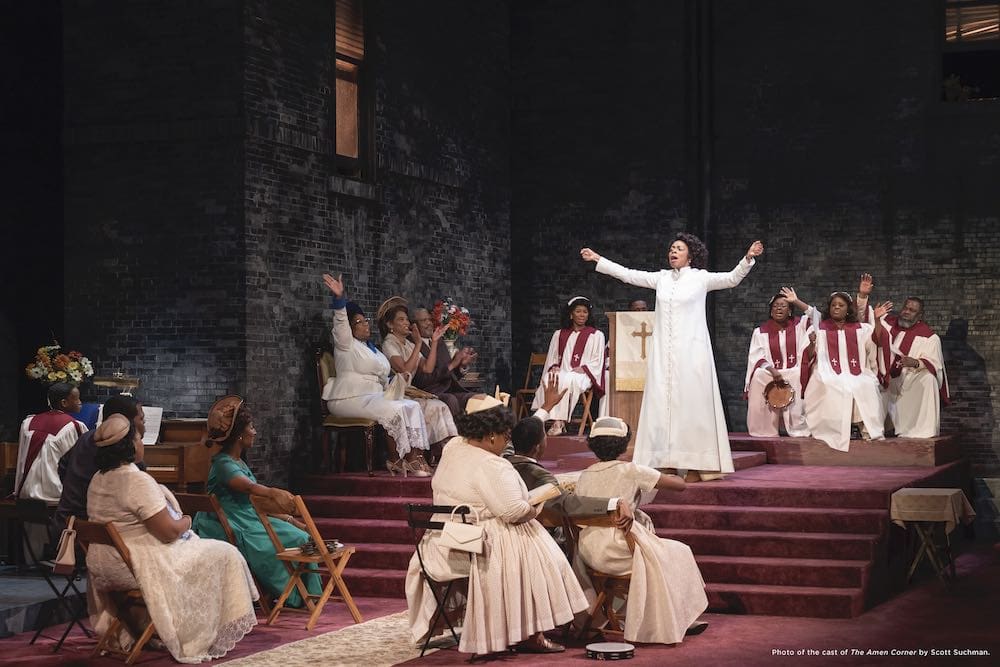
Shakespeare Theatre Company has brought The Amen Corner home in a magnificent production that has been getting critical raves and rapturous audience praise. Its gifted director, Whitney White, is not new in town. She directed a powerful work by Aleshea Harris called What to Send Up When It Goes Down that late last fall toured four community venues then had a sold-out run at Woolly Mammoth Theatre Company. In form it was a ritual by, about, and for Black people; its content was a response to racialized violence.
I was eager to talk with her because I attended and reported on What to Send Up at each of its tour stops, and I had come to an enormous appreciation of how tightly directed and committedly enacted it was. It seemed absolutely real and true and in-the-moment, every time as if for the first time. So I began by asking how she did it.
John: Would you talk about how as director you achieved that extraordinary sense of personal presence without seeming like performance?
Whitney: When I first read the script, I had a physical and emotional response. It felt very much like a piece of music, it read like a score, with intense rhythms, aggressive spoken language, and beautiful moments of quiet. Then there were all the moments that called for choreography and the songs that Aleshea has written. So the entire work manifested for me like a sonic and physical experience. And I knew the movement had to be something that could activate the actors. The choreography couldn’t be superfluous, it wasn’t about a step-step-touch routine. So when I started choreographing it, I knew I wanted to find things that could allow the actors to fall deeper into the purpose of the piece. And the purpose of it is to celebrate Black men, women, and children who’ve lost their lives to racialized violence. I wanted it to feel ritualistic, but I also wanted it to be something that actors needed. The movement isn’t for the audience. It’s not decorative. It’s necessary. So I knew I had to pull this incredible text together with purposeful choreography, with the beautiful songs Alesha had written then with the purpose of the evening, which is to celebrate and acknowledge Black lives.
When you were directing The Amen Corner, was your process similar?
When I read The Amen Corner, I also had a very physical and emotional response to the story. The play is focused on a mother trying to keep her home and church together while also zooming in on a Black community that is dealing with issues of power and safety. I had a physical response to Margaret as a single Black woman trying to hold her world together, trying to keep her seat of power. But I also had a physical and emotional response to David in the story, because I identify with this young man whose family is trying to keep him close to home and away from the outside world. The dangerous, white world. And he, David, wants to go out there and be an artist, which is a dangerous thing even to this day. So I had a similar response. But what’s different is that The Amen Corner is told on such an epic scale. You see the inside and outside. And my mantra for directing it was: It takes a village. I feel that’s very true in the Black community. We have to pull so many resources from so many places just to survive. And I wanted to make a world that felt like the village was always there. Everything was always on view and privacy was very hard to have. The piece is very different [from What to Send Up] structurally, but I still wanted to have movement and music. That’s the root of it that activated the actor. The choreography you see in The Amen Corner really was generated with the actors. In the church services, for example, we looked at video and researched and a lot of people in the cast had experience with movement that surrounds Black worship. But we added things to activate the actor: what do you need in this moment to be as emotionally radically vulnerable as possible? What both pieces share in common is radical vulnerability.
My next question is about the problematic history in American theater of how white audiences watch Black people perform.
Oh God.
I’ve seen shows where the cast is all Black and the audience is almost all white and I can sense some of that problematic history still happening—you know what I mean?
Yeah, yeah.
What to Send Up changed the terms of that history dramatically. It was unapologetically Black, it was about Black lives, and it was explicitly not about centering the experience of white audiences. So my question is: During production of The Amen Corner, did that problematic history come up in your mind? And if so, how did your direction bend that history toward justice?
Wow. First of all, I want to thank you for that question. It’s not many journalists that are looking at that so deeply and I’m grateful that you asked it. You know, it’s a complicated thing, the history of viewing the Black body in America—that’s what we’re talking about. Every form of entertainment you see that you consider to be American really comes from a community of Black people who were taken from their homes and brought here. Singing and dancing and laughter and worship and movement was always a form of survival and defiance; and that survival and defiance, those mechanisms, have been appropriated by mainstream culture—jazz, hip hop, contemporary music and movement as we know it. So we have this longtime history of being culture creators but not often recognized for it. And then you come to the theater, which is usually predominantly white audiences, and people are looking to digest entertainment, looking to have catharsis, looking to feast, you know, on the Black body in these ways.
We had really great conversations about it. I was gifted on The Amen Corner with a very incredible cast of professionals, from E. Faye Butler to some of my students at Howard. And they all were actively engaged with their own artistry and the way they engage with white audiences, so it wasn’t the first time they had these conversations. Turning it into justice is such a great question because I often told the actors, “Give the moment what it needs.” Like, you’ll go to a musical on Broadway and at the end they’ll come out after the curtain call and sing and dance a whole new number and they’re turning out to the audience and they’re working so hard for the white gaze. In The Amen Corner there are many moments when the dancers’ backs are mostly to the audience—for example in Act Two when Sister Moore does that beautiful service, with the thunder and lightning—because that moment is for them; it’s not for the audience. You can witness it but you are not invited into it the same way you are in the opening service—because the dramatic circumstances have changed and the community now needs to look in within itself to decide what to do about Margaret. Often the way that I tried to deal with this issue of the gaze and having it be dignified and having there be justice in it was to just remind the actors, “Hey, you don’t have to overwork in this moment. Do what you feel. Do what you need.” So we broke traditional musical theater logic sometimes to honor the truth of what it feels like to be viewed by a white audience.
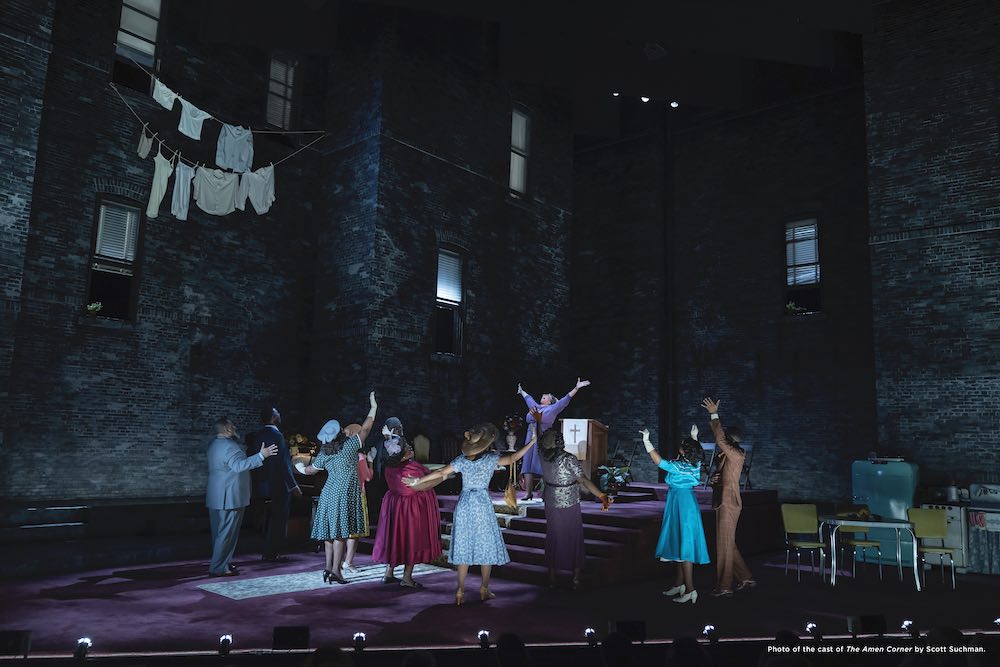
The action of Baldwin’s play happens among Black people in a particular community—though it’s very accessible to non-Black audiences and can be appreciated as universal. But Baldwin, never one to hold back, clearly meant it to tell some Black folks’ family business, to air some laundry—a metaphor that literally hangs over the set. How as a director did you approach both that universality in the play and that particularity in Baldwin’s intent? Put another way: How do you think about and direct a work that racially, and necessarily, has a dual audience?
Well, in a way it was refreshing for me to work on a piece that dealt with Black people dealing with each other and trying to survive with each other—intraracial relationships versus interracial relationships. Sometimes when you’re working on a play with non-Black characters, it so fast becomes about them. I call it the Iago effect. Othello is a play I work on a lot in my artistic life. I’ve directed it, I was an associate on it once, I’m doing a music adaptation of it. But the play is called Othello and every time I go see it, it’s the Iago show. It’s insidious how white characters can take over our own narratives. So it was incredibly freeing just to focus on this little amen corner, this corner of life, this microcosm of Black spiritual life in Harlem. I didn’t have to take extra care of anyone or step outside myself in any way. And we had so many beautiful, honest, easy moments in rehearsal. I was like, this is too good to be true.
How do you hear Baldwin’s voice in The Amen Corner? Is it the voice of the preacher he was as a boy, the justice oracle he became as a man, the poet he always was—?
Everybody knows James Baldwin as the political activist, the man doing the brilliant speeches, the man dealing with racism in America and preaching and educating about that. But I feel here we get to see Baldwin as an artist. He is really making a world with character and plot and emotion and I feel his voice pop up in every character, even our fierce Sister Moore. When she says [of Sister Margaret], “If you think this woman who can’t bring peace to one person can bring peace to a whole lot of people,” I hear Baldwin there that we as Black people are looking for peace and light. I hear it when David says, “Mama, who’s going to speak for us?”—because Baldwin turned away from that religious community to speak for himself and for us. I hear it when Luke is dying and confronts Margaret and confronts the hypocrisy of the lifestyle that she has chosen to lead. Because Baldwin allowed himself to make this play that was focused on the Black community, he was able speak so many ways, with so many points of views through different characters. He gets to have his voice come from the many.
What about this time and this town makes The Amen Corner mean more than when it was written?
Baldwin’s play is kind of a masterpiece, and it’s crazy to me that it hasn’t been done at every regional theater with a major cast and budget. But it was particularly powerful doing it in DC. It was a homecoming. It had its time at Howard; Baldwin himself spent so much special time in DC. And DC is also the capital of our nation. The conversations I had with people in DC about politics and race and theater and music were so rich, and it just felt very important to bring the work back home there before it hopefully spreads across the nation again. I purposefully tried to work with as many DC-familiar or DC-local artists as possible. That’s also what made it feel so special to the region, I wanted people to come and see themselves reflected on stage, not just because they’re Black, but because they’ve been in shows you love, you might know them. The strongest aspect of The Amen Corner is the notion of community, and so I was like, I need to invite the DC community into the work as early as possible. It just felt right for me to do it here because I feel like here I could really focus on community building and the story—less glitz, you know, less of the hype, just focus on the play itself. I had the space to do that in DC, which I’m very grateful for.
The location as written is a storefront church and you and the design team have opened it up on a grand opera scale.
Yes, the designers took what was in the text and exploded it in such a thrilling way!
Would you talk about your impulse and vision for that expansion?
Daniel Soule, our set designer, and I have been working together for several years. When we had to visit the theatre, we took the train down to DC and we sat and just felt the aura of the space. The Harman is so vast. People who had worked there in the past told me, Oh, that’s the hardest thing about it; you’re going to want to cut it down. But we thought, No, this space’s greatest asset is its size. We wanted to embrace it however we could.
I kept telling Daniel that I wanted to feel in a real way that the inner emotional world is the outer world and vice versa, because I kept imagining how invasive it would be to be Margaret, trying to make your breakfast after you preached all morning and then people just come into your house. I don’t know what I would do in that situation if I always had the watchful gaze of the community literally in my home. So we expanded that idea. I was like, Let’s put it all outside. And Dan was drawn to the world of film noir, which manifested in the black brick walls. And it was just the greatest way to obliterate the traditional structure and go for the emotional feeling of the landscape.
I was so impressed with the way the production moves back and forth between the church drama and the family drama, from ritual/ecclesiastic to kitchen and bedroom, between the gorgeous and moving big music scenes and the smaller domestic scenes where some of the darker themes are.
Thank you. DC kind of welcomed me on both productions with open arms, and I’d like to say, Oh, it’s all me and the design team and we thought it all up. But what makes theater theater is the community you do it in and the people you do it for. I travel around directing a lot now, which I’m very grateful for, but being welcomed, welcomed in, it just sets the tone of the work you’re able to make.
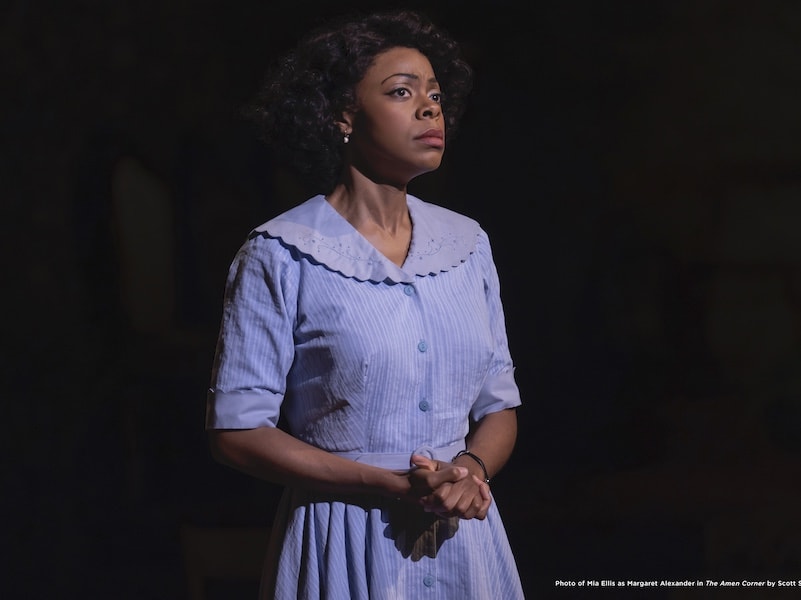
In many ways The Amen Corner is a play about women. The main character is Sister Margaret, a Pentecostal minister. Women are the mainstays of the congregation. And for a script written in 1955, it can be very proto-womanist, like in that line where Margaret says:
The only thing my mother should have told me is that being a woman ain’t nothing but one long fight with men. And even the Lord, look like, ain’t nothing but the most impossible kind of man there is.
And later when Brother Boxer says:
Sister Margaret weren’t nothing but a woman who run off from her husband and then started ruling other people’s lives because she didn’t have no man to control her.
What do you make of Baldwin’s sexual politics in the play?
It’s outrageous, isn’t it? Sometimes when I’m reading The Amen Corner, I feel the way I feel about Hedda Gabler: Ibsen wrote an extremely bold, noir, radical sex art femme piece, and I don’t know how he did it but I feel the same way about Baldwin. This was the era of the politics of Black respectability. Dr. King is coming and the Civil Rights Movement is coming and so many people felt the only way to advance our ethnic group was through perfectionism and showing our best side. And Baldwin says, Let me show you this side, these women, Odessa, Sister Moore, Sister Boxer and Margaret. I mean, they have some of the most intense intellectual dialogues about power and faith and what a woman should be like in order to be in power. It feels incredibly forward-thinking. Baldwin has imagined a world of women leaders. The other church that’s talked about is also run by a woman, and then Sister Moore takes over the church [that Margaret led]. Baldwin has envisioned this world in which Black women rule, literally. And it was very, very fun to get into doing that. I think Baldwin’s showing how Black women can be pillars of our community, and he’s showing that in a unique way. He’s also showing us in an imperfect way, which I think is really good, because we’re living in the time of the independent woman who can do it all. That’s a myth that breaks women’s backs. And Baldwin is showing that we are human. Powerful but still human.
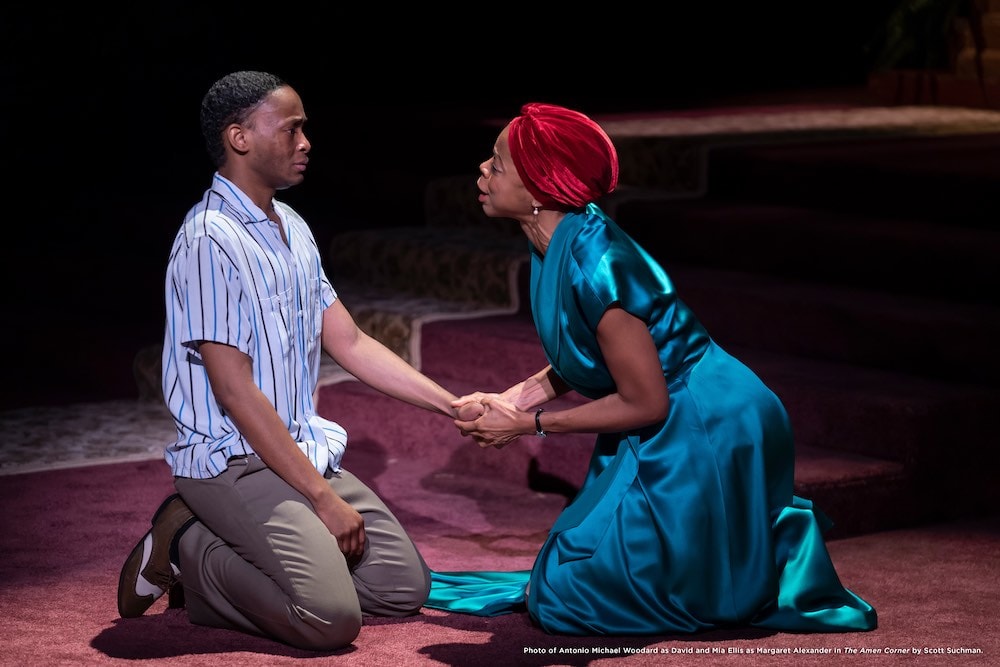
There’s a main plot and a subplot. The main one is about Margaret’s fall: the congregation learns she has deceived them and they turn on her. The subplot is about David, Margaret’s musican son, and his journey to liberation—which you have called a queer narrative. Would you talk about how Baldwin relates those two story lines, and how what’s female-centric and what’s queer in the play connect?
I think that David’s story has a very queer aspect to it because he goes against what he’s supposed to go toward. He comes out by the end of the play into his artistic self. He admits, “Mom, I’ve been lying to you for a long time and I don’t want to lie anymore.” It’s that brave moment of declaring to the people that you love, something that many people who are minorities—whether you are a person of color or Black or queer, LGBTQ, questioning, anything—there’s that moment when you have to say to the mainstream or to your own family, Hey, this is who I am and I don’t want to lie about it anymore. That language is so, so specific and beautifully honest. David says, “I can’t stay here in this house. I don’t want to hate you. I don’t want to tell any more lies. I’ve seen your life. And I’ve seen my father’s life and I want my own life.” And that’s where I get the idea of queerness. He’s been trying to pass as his mother’s idea of a good child and finally he can’t.
We have David’s story against a very Julius Caesar kind of power takedown, the other story of Margaret. This is also why the play is relevant for DC: It’s a chilling look at groupthink. It’s hard to say who’s right and who’s wrong. Sister Moore can be viewed as a villain but she’s not. She’s genuinely looking for peace for her religious community. And Margaret has been lying to that community. But if we’re talking about God and Jesus and faith and love, is it right to push her aside in that way? Sister Moore systematically wins over the hearts and minds of the people to the point that by the last scene they’re trying to make their own decisions but the decision’s already been made. It’s a very chilling look at what happens when humans group and are fearful because ultimately they’re just trying to keep their corner of the world safe from the dangerous outside world. Fear drives us to groupthink in what can be very odd ways. So it’s interesting to have the story of a young man coming out against the group and then that group eating itself and spitting one out. You have a quintessential look at the individual versus the group. What is the individual citizen’s responsibility to groupthink and group politics and what is the point at which you can’t follow the group anymore?
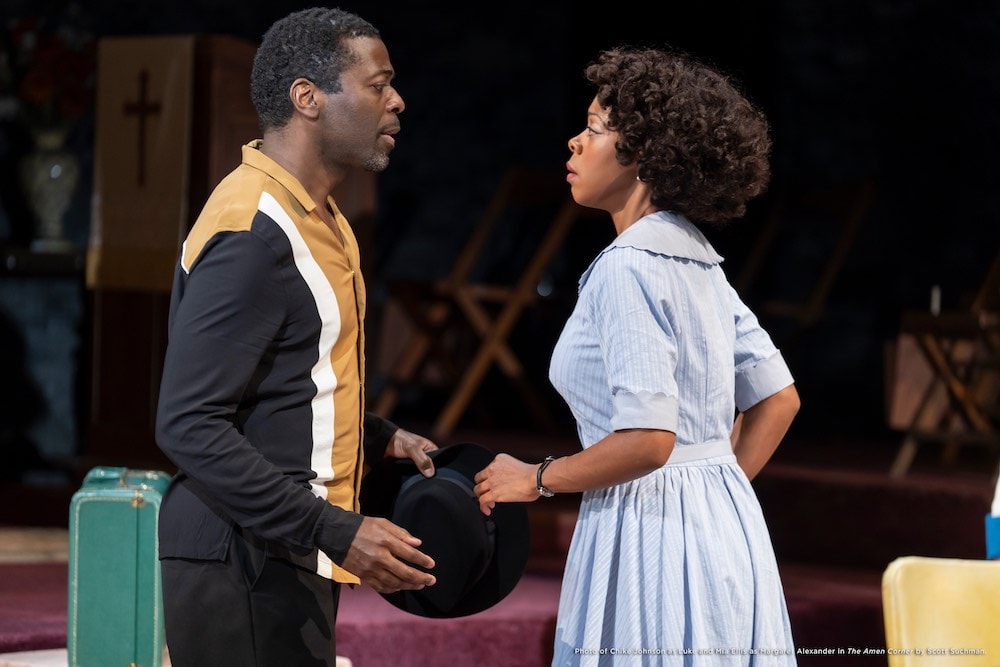
There’s also a love story in the play, an embattled one, between Margaret and her wayward husband Luke, and there’s an almost unbearably emotional scene before he dies where it all unfolds—
I know!
—and it took my heart away. How as a director do you know when you’ve got a scene like that to work so it will work for the audience? Because it was just overwhelming to watch.
Well, Luke’s bedroom takes up the smallest real estate of the stage. It’s all the way stage right in this intimate little corner. And I credit the power of that scene to the two actors, Chiké Johnson [Luke] and Mia Ellis [Margaret], because they had a beautiful chemistry and way with each other from day one. They had an immediate respect for each other that translated every single day when we were working. It was inspiring to see. I kept holding onto: We never do things in the right time. That was my only guiding light there. Something will happen and you’re full of regret and you’re full of: I wish, I should, I did this or I should’ve done that, or “if only I could start again”—which is what Margaret says. And I wanted the scene to be over before I could feel like it was over. To me that’s what life feels like. You always think you’re going to have another minute to say the things you want to say to the people you love or to get what you want or to be honest or true to yourself. And then boom, life subverts that. And when Luke dropped the trombone mouthpiece, I just wanted to feel like it came too soon.
Finally, I wonder if you would respond to this passage from Baldwin’s introduction to the play:
I was armed, I knew, in attempting to write the play, by the fact that I grew up in the church. Knew that out of the ritual of the church, historically speaking, comes the act of the theatre, the communion which is the theatre. And I knew that what I wanted to do in the theatre was to recreate moments I remembered as a boy preacher, to involve the people, even against their will, to shake them up, and, hopefully, to change them…
Wow. How brave is that to look back on your own childhood, on people you loved and people who probably loved you, and to try and change those people and people of the now and people of the future? I just think it’s a testament to his brilliance as an artist and political, intellectual seeker to be able to take his own very specific experience. I mean, how much more specific could you get than being a boy preacher? That’s not something most of us in America have experienced. And somehow he takes this hyperspecific human experience and you’re watching in the audience and you’re like, This is my story. And it’s just incredibly bold and dangerous. I love what you said: The laundry is literally on the stage. Baldwin is doing something that could have really, really cast him out of the community at the time. But he’s doing it so honestly and with such empathy that you don’t feel that he’s talking dirty about his Black community. You feel like he’s trying to understand that. I’m incredibly moved by that quote because he took the personal and made it universal. So if he can do it then maybe we’re all not that different at all. It’s really hopeful. You know, if a white audience member who lives in DC can come and see this story inspired from the experiences of a Black boy preacher, then maybe we’re not so across the divide as we thought.
Running Time: Two hours and 30 minutes, including one 15-minute intermission
The Amen Corner plays September 14 to 26, 2021, at the Harman Center for the Arts, Sidney Harman Hall, 610 F Street, NW, Washington, DC. For tickets, call the box office at (202) 547-1122, or go online.
READ Ramona Harper’s review, “James Baldwin’s ‘Amen Corner’ bears witness to the Beloved Community”
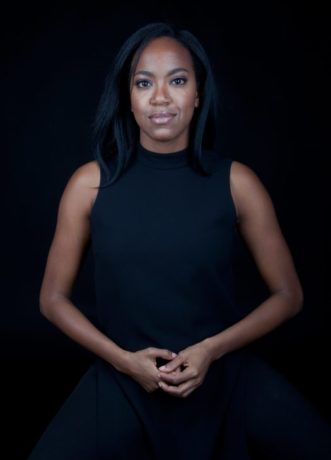
Whitney White
NEW YORK: WP Theatre/Second Stage: Alexis Scheer’s Our Dear Dead Drug Lord | Soho Rep: Zawe Ashton’s for all the women who thought they were Mad | The Movement: What to Send Up When It Goes Down (New York Times Critic’s Pick). REGIONAL: Williamstown Theatre Festival: Jonathan Payne’s A Human Being, of a Sort (starring Andre Braugher and Frank Wood) | PlayMakers Rep: Jump (National New Play Network Rolling World Premiere) | IAMA Theatre Company: Canyon (LA Times Critic’s Choice) | Long Wharf Theatre: An Iliad | Juilliard: Rita Tambien Rita | Trinity Rep: Othello | Endstation: Br’er Cotton. OTHER: Associate Director: Broadway: Marvin’s Room | Roundabout Theatre Company: If I Forget | Atlantic Theatre Company: The Secret Life of Bees. Whitney is an Associate Artist at Roundabout. AWARDS: Recipient of the Susan Stroman Directing Award. Past fellowships: 2050 NYTW Fellow, Ars Nova, Drama League, the Inaugural Roundabout Directing Fellowship, and Colt Coeur. PERSONAL: Whitney’s original musical Definition was part of the 2019 Sundance Theatre Lab and her musical look at Macbeth, Macbeth in Stride, was part of the 2019 Under the Radar Festival (Public Theater). Training: Brown University/Trinity Rep: MFA, Northwestern University: BA.
SEE ALSO:
Elegies for empty stages, by Whitney White and Psalmayene 24
Whitney White and Soyica Colbert join Shakespeare Theatre Company




